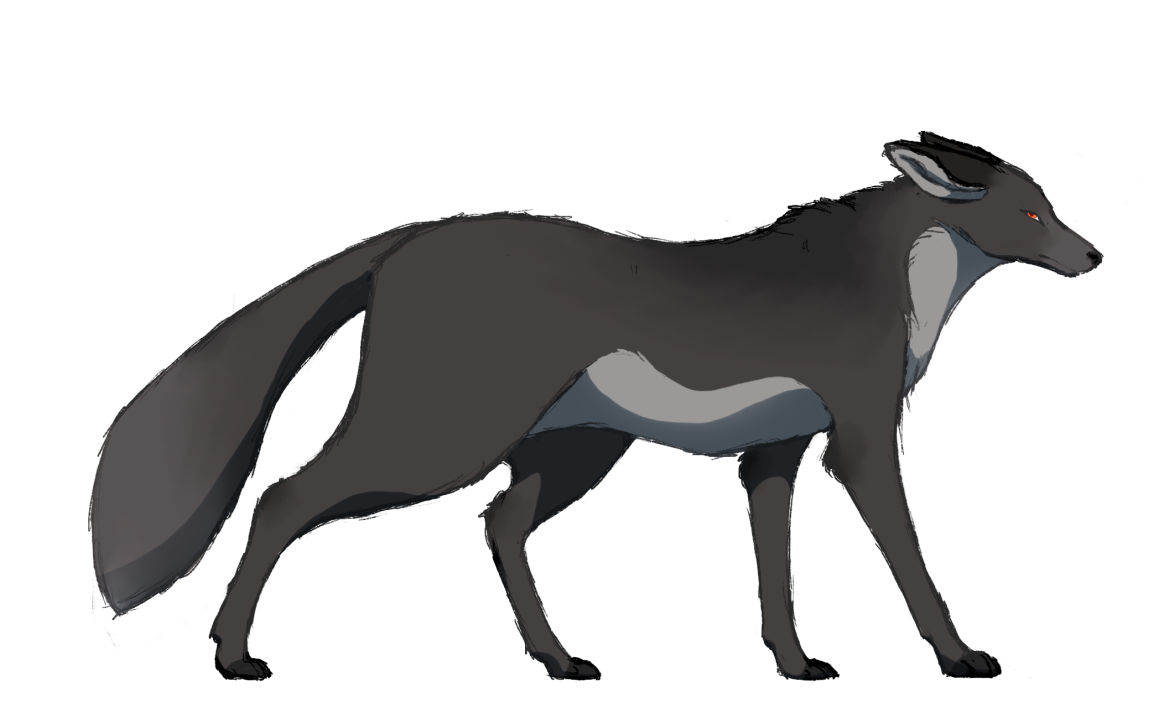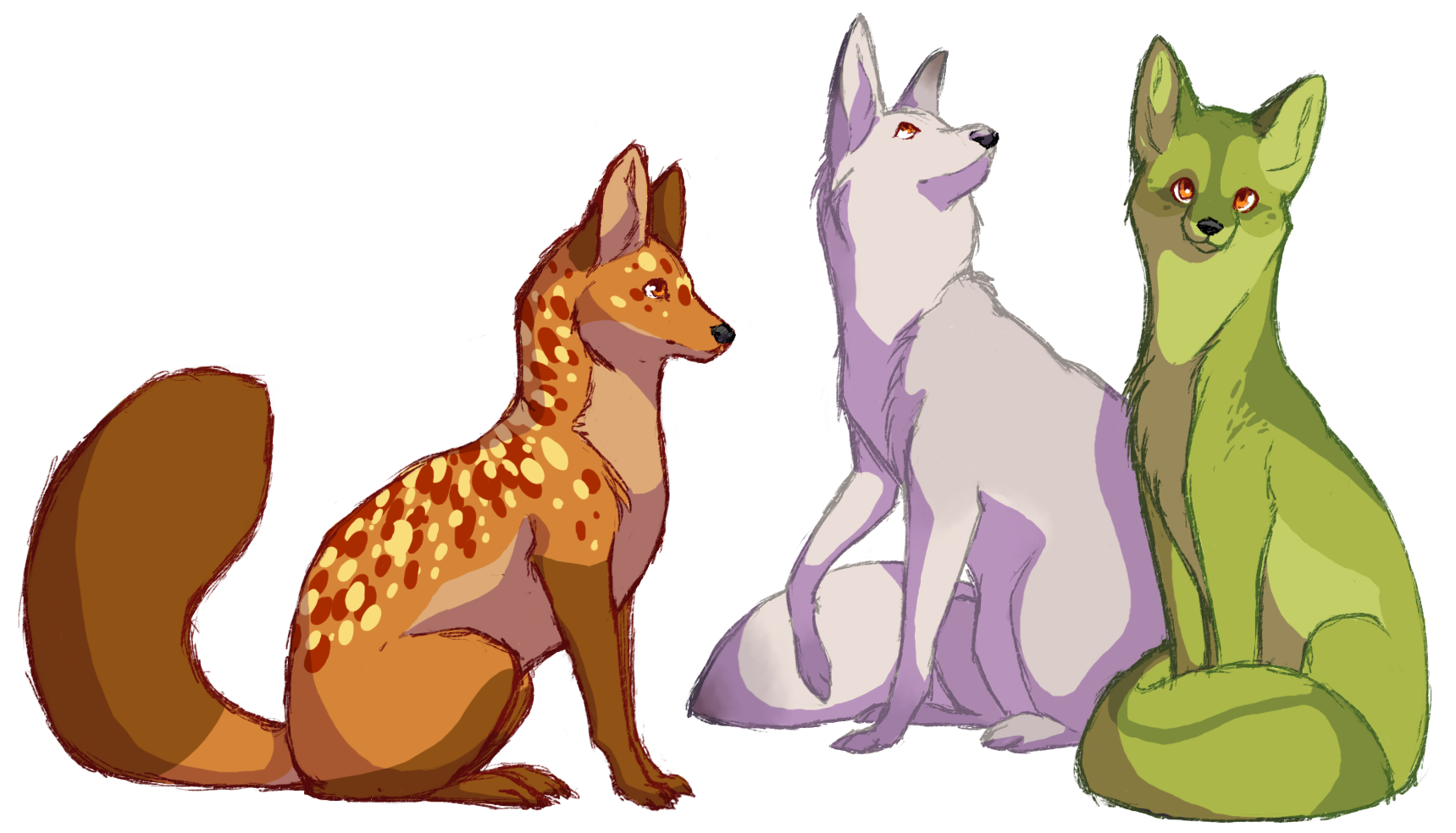The Tiaplos
All the animals drawing here were done by the talented Graphi for this article.
Tiaplos look like big foxes, being more or less the size of an average dog. They are also entirely wild as many attempts to tame these animals failed in the past.
Almost every inhabitant of Menicea knows them as they are broadly feared by travelers of all kinds.
At first sight, what could they possibly fear from a 50cm tall fox that they can probably chop in half as soon as he gets close? Regardless of how sharp their teeth may be, the main difficulty with dealing with Tiaplos is that you will most likely not see them coming at all.
♪ If you go out don't ever walk alone,These little pests can change the pigmentation of their fur to match their environment, and evolution taught them to stay silent and to approach a prey without being noticed. The only thing that remains visible throughout their transformation is their round orange eyes. Since they bet everything on a surprise attack, they don't fear to attack a bigger prey which includes Gérouns, Humans or whatever they find wandering alone in the wild. If being nearly invisible wasn't enough, Tiaplos only live and hunt in packs, meaning that you will get attacked by at least five of them at the same time.
Who knows when Tiaplos are around,
Who knows if you are on your own,
That you might just fall on the ground,
Bitten to death a thousand times. ♫
Fierce Tiaplo by Graphi
Cultural impact
Tiaplos have inspired many songs, poems and appear in a lot of books, from novels to encyclopedias. The danger they represent and the number of people they killed had a tremendous impact on how people now organize their travels. There were a lot of deaths when they first started to spread all around the continent. People planned big hunts involving all the village to get rid of local packs. They were one of the two big reasons that made the kingdom create the Territorial Patrols back in 113. Even though it wasn't enough to get rid of them on the roads, they still became a lot rarer. Tiaplo fur is very common in Menicean markets since they are still actively hunted. Many unaware merchants from overseas get fooled by locals to buy some dyed fur. They think that they just bought one of the hides that kept its camouflage after the animal died. As you can guess, the seller is long gone before they can even find out the trick.ANOTHER TIAPLO ATTACK
Another caravan of sien-grissos scientists got attacked by the well-known pack of Tiaplos that is hiding near the capital.
Only two humans survived and ran to the nearest village as the predators were taking the corpses away. The two other humans died and, unfortunately, two Gerouns that were escorting the caravan perished.
It is yet another attack on our brothers that keep us wondering what the patrols are doing. This pack has been known for a now two months and has yet to be slain by the army.
Basic Information
Anatomy
Changing their appearance doesn't seem to be much of an effort to them, but it has been observed that a dead Tiaplo's fur will turn to a dark grey/black color as it's dying.
Human scientists also made researches and comparisons with regular foxes and found that both species share the same skeletal structure.
Genetics and Reproduction
Females attain their sexual maturity at 8 months of age. Males tend to be mature one month earlier and will start to find a mate before winter. Just like foxes do, Tiaplos will always mate with the same partner until one of them dies. Males will aggressively defend their female if anyone tries to approach her meanwhile.
Tiaplos reproduce just before spring arrives, the warm season being the perfect time for babies to see the light of day. They leave the pack when the cold season approaches and will live as a couple until late spring. Once the female is pregnant, the pair will get away as much as possible from roads and cities to build a comfy den.
The male will provide the food for the two of them as the female will leave less and less the den as she becomes more and more exhausted by her pregnancy. Each litter has more or less than 4 babies that will be born after approximately 60 days of gestation.
Once the babies are born, they will stay inside of the den for a month with their mother keeping them warm and fed. The male will keep finding food for himself and his partner and strive to keep predators away.
After this month, babies will be allowed out of the den, and the little family will look for their pack and get back to their group activities.
Growth Rate & Stages
As said in the genetics part, Tiaplos grow from newborn to adult in about 8 months. Babies are blind and deaf at birth and so will stay under their mom's vigilant protection during their first days.
They begin to hear after a few days and to see after a week. Their legs will be ready to run after another 5 days or so and babies will start to play with each other.
After hiding for a month in their den, the young animals are ready to go out. They will follow their parents as they search a pack to join and will stay close to them during all the summer and early autumn. Both males and females will learn to hunt with the adults so they can handle themselves when winter arrives.
Their body will be mature when the middle of autumn approaches as they will start to look for a lifelong mate.
Tiaplos can live up to 9 years. The oldest specimen ever seen was said to be 13 when it died.
Tiaplos Cubs by Graphi
Ecology and Habitats
When living in a pack, Tiaplos don't worry about burrowing as they are always using their camouflage. They count on their number to deal with any stranger that gets too close. Still, they learned to stay away from any sapient-looking species as they "know" that they are not wanted around.
They will try to find a place with a source of water nearby, if possible with the high grounds so they can spot any potential prey that would come for a drink.
As a couple, they will seek a humid place to build a den that should provide enough smell-covering mud for the female and the babies to roll in. Only the male will stay out of the mud since he is the one that goes out and needs his visual camouflage.
Biological Cycle
Seasons have an impact on Tiaplo's behavior and fur. Their coat will grow thicker during the cold seasons to protect them from the cold, like many other mammals.
They live in packs half of the year, from the late spring to the late autumn, after what they'll spend the cold season with their lifetime mate.
Additional Information
Social Structure
Even though Tiaplos don't have a huge hierarchy in their packs and couples, they still have some roles and rules that have to be respected.
When in a pack, a Tiaplo will go through three big steps during its life.
From their birth to 1-year-old, they are considered to be children. As soon as they stop drinking milk, they will receive the best food to make sure they grow strong and healthy. They will also learn how to hunt by watching the adults from far away and learn how to make the best use of their camouflage.
From 1 to 5 or 6 years-old, they will be adults. They are the ones who bring the food to the pack and protect their territory from intruders.
From 6 years old to their death, they will be elders. The old specimens will pick, then watch over the territory. If they spot any intruder coming, they will howl in a way that's specific to each pack to alert the adults that will come back to defend their home. Elders also get to choose if a couple should leave the pack if they are judged useless to the hunt or if the pack is too big.
The first winter can be pretty harsh for young males, as they have to fight for females. Once they find a mate, they will stay with her for the rest of their lives, unless they get killed by another young male later which doesn't happen often. If a male doesn't have a mate, he will spend the winter as a vagrant and will have to survive on its own. He will still be allowed into the pack at spring, but he will have high chances of getting kicked since he just had a very exhausting winter.
The first winter can be pretty harsh for young males, as they have to fight for females. Once they find a mate, they will stay with her for the rest of their lives, unless they get killed by another young male later which doesn't happen often. If a male doesn't have a mate, he will spend the winter as a vagrant and will have to survive on its own. He will still be allowed into the pack at spring, but he will have high chances of getting kicked since he just had a very exhausting winter.
Geographic Origin and Distribution
Tiaplos are said to be native to Mt Odelia, a mountainous region to the north-west of the continent. They'd have started to spread in the neighbor plains, and then in the rest of Menicea during the following decades. No one knows why they seemed to be stuck in the mountains during the Great Clans Wars since they only started to be seen in other regions around the year 17 (250 is the current year).
Perception and Sensory Capabilities
A Tiaplo's brain processes visual information way faster than a Humanoid one would do, making everything going slower for them. Even though that's nothing different with a regular canine, it is still worth considering.
Their sense of smell is also very developed, as they tend to go after preys that are already bleeding if the choice presents itself. Even if that's very unlikely to happen, they still keep in mind their current prey's smell in case it manages to run away from their assault.
Scientific Name
Lycalopex Chamaeleonidae
Origin/Ancestry
Native of the continent
Lifespan
8-9 years
Average Height
50 cms
Average Weight
12 kgs
Average Length
1 meter






Comments